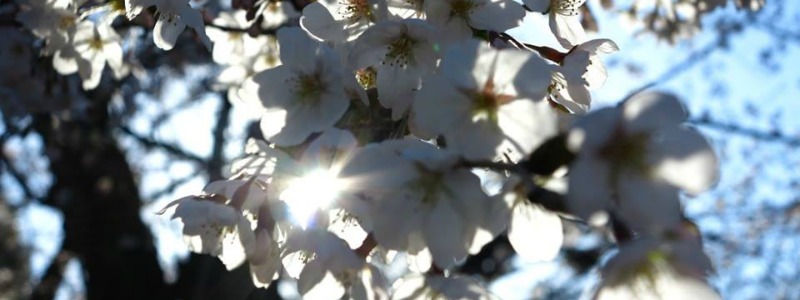Table of Contents
- Sakura Varieties
- Someiyoshino Color: white, faint pink / Season: late March-early April
- Edohigan Color: white, faint pink / Season: mid-late March
- Oshimazakura Color: white / Season: March-April
- Yamazakura Color: white, faint pink, dark pink / Season: March-April
- Kawazuzakura Color: pink / Season: late January-March (varies by area)
- Ohkanzakura Color: faint pink / Season: mid-late March
- Kanhizakura Color: dark pink / Season: Jan-early Feb (Okinawa), Feb-Mar (south of Kanto)
- Oyamazakura Color: pink / Season: mid-late April
- Shidarezakura (Weeping Cherry) Color: pink, white, red / Season: late March – early April
- Yaezakura Color: pink / Season: mid April – early May
Sakura Varieties
When referring to cherry blossoms the single term “Sakura” is commonly used. However, there are well over 300* different kinds of Sakura including wild ones and cultivars. Each vary in size, colors, shape and number of petals, the climate they grow in, as well as the way the blossoms open, the timing they bloom, the time they last, and the life span of the tree. Sakura trees are not only seen in the wild and as roadside trees, but are also a Japanese favorite horticultural plant and are constantly cultivated, resulting in an increase in varieties.
* Number differs by source
Below is a brief guide to some of the most popular and famous kinds.
Someiyoshino Color: white, faint pink / Season: late March-early April
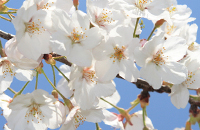 Someiyoshino (ソメイヨシノ) is a hybrid of Edohigan and Oshimazakura. It is the kind most widely seen across Japan, and is the one commonly used for blossoming forecasts. It does not propagate by itself and are clonally reproduced by human hand, such as by grafting. For this reason, despite the centuries-long life of its parents, one generation of Someiyoshino only lives for several decades.
Someiyoshino (ソメイヨシノ) is a hybrid of Edohigan and Oshimazakura. It is the kind most widely seen across Japan, and is the one commonly used for blossoming forecasts. It does not propagate by itself and are clonally reproduced by human hand, such as by grafting. For this reason, despite the centuries-long life of its parents, one generation of Someiyoshino only lives for several decades.
Edohigan Color: white, faint pink / Season: mid-late March
 The name of this kind derives from its blossoming time around spring equinox (around March 21), just a little earlier than Someiyoshino. Edohigan (エドヒガン) trees have a very long life span, with some living over a millennium, and is often appreciated not only for its beauty but also for its dignified appearance that comes from age. The oldest and famous ones are estimated to be 1,000-2,000 years old.
The name of this kind derives from its blossoming time around spring equinox (around March 21), just a little earlier than Someiyoshino. Edohigan (エドヒガン) trees have a very long life span, with some living over a millennium, and is often appreciated not only for its beauty but also for its dignified appearance that comes from age. The oldest and famous ones are estimated to be 1,000-2,000 years old.
Oshimazakura Color: white / Season: March-April
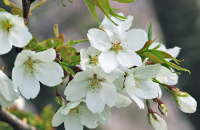 Oshimazakura (オオシマザクラ) grows in the warm islands of Japan, especially in the Izu Islands where it got its name from. Blossoms are white and the leaves are used for a seasonal Japanese confectionery called Sakuramochi. Being an island Sakura it is strong against sea breeze. It is also a parent of numerous Sakura cultivars including Someiyoshino. If it had not been for this one, there might not have been so many different cultivars.
Oshimazakura (オオシマザクラ) grows in the warm islands of Japan, especially in the Izu Islands where it got its name from. Blossoms are white and the leaves are used for a seasonal Japanese confectionery called Sakuramochi. Being an island Sakura it is strong against sea breeze. It is also a parent of numerous Sakura cultivars including Someiyoshino. If it had not been for this one, there might not have been so many different cultivars.
Yamazakura Color: white, faint pink, dark pink / Season: March-April
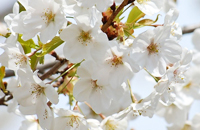 Yamazakura (ヤマザクラ) is the most common kind of wild Sakura. Unlike Someiyoshino, the leaves come out at the same time as the blossoms. They are particularly known for having rich variety in the colors of blossoms and young leaves, the way and numbers the branches put blossoms, and the timing they start blooming, even within the same area. This diversity allows a sight of multiple colors at once and a long viewing period.
Yamazakura (ヤマザクラ) is the most common kind of wild Sakura. Unlike Someiyoshino, the leaves come out at the same time as the blossoms. They are particularly known for having rich variety in the colors of blossoms and young leaves, the way and numbers the branches put blossoms, and the timing they start blooming, even within the same area. This diversity allows a sight of multiple colors at once and a long viewing period.
Kawazuzakura Color: pink / Season: late January-March (varies by area)
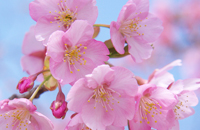 Kawazuzakura (カワヅザクラ) is believed to be a natural hybrid of Kanhizakura and Oshimazakura, and is one of the earliest Sakura to bloom, so early that it is many times confused with plum or peach. As compared to Someiyoshino the blossoms are darker in color, and the bark is also pink-purplish. The blossom is single-layered, rather flat and faces slightly downwards.
Kawazuzakura (カワヅザクラ) is believed to be a natural hybrid of Kanhizakura and Oshimazakura, and is one of the earliest Sakura to bloom, so early that it is many times confused with plum or peach. As compared to Someiyoshino the blossoms are darker in color, and the bark is also pink-purplish. The blossom is single-layered, rather flat and faces slightly downwards.
Ohkanzakura Color: faint pink / Season: mid-late March
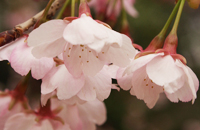 This kind has small slashes in the petals. Resembling Kanhizakura, which it is believed to be one of the parents, Ohkanzakura (オオカンザクラ)’s blossoms do not open all the way and face downwards. It blossoms about one week earlier than Someiyoshino and has a fairly long blossoming span.
This kind has small slashes in the petals. Resembling Kanhizakura, which it is believed to be one of the parents, Ohkanzakura (オオカンザクラ)’s blossoms do not open all the way and face downwards. It blossoms about one week earlier than Someiyoshino and has a fairly long blossoming span.
Kanhizakura Color: dark pink / Season: Jan-early Feb (Okinawa), Feb-Mar (south of Kanto)
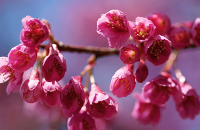 Kanhizakura (カンヒザクラ) is also a wild kind that can be found in the warmer regions. In Okinawa, when they say Sakura it’s Kanhizakura. Because it originates in the subtropicals, it is weak against cold and cannot be grown in the northern regions. Its most distinctive feature is the dark scarlet color and bell-like shape with the petals opening only half way and drooping like campanula.
Kanhizakura (カンヒザクラ) is also a wild kind that can be found in the warmer regions. In Okinawa, when they say Sakura it’s Kanhizakura. Because it originates in the subtropicals, it is weak against cold and cannot be grown in the northern regions. Its most distinctive feature is the dark scarlet color and bell-like shape with the petals opening only half way and drooping like campanula.
Oyamazakura Color: pink / Season: mid-late April
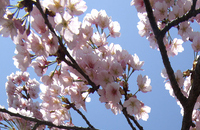 Oyamazakura (オオヤマザクラ) can be found in the northern half of Japan, and for its hardy characteristic it is seen widely in Hokkaido. When they say Sakura in Hokkaido, it is most likely to be this kind. It puts on blossoms and leaves both relatively larger than other Yamazakura kinds.
Oyamazakura (オオヤマザクラ) can be found in the northern half of Japan, and for its hardy characteristic it is seen widely in Hokkaido. When they say Sakura in Hokkaido, it is most likely to be this kind. It puts on blossoms and leaves both relatively larger than other Yamazakura kinds.
Shidarezakura (Weeping Cherry) Color: pink, white, red / Season: late March – early April
 Shidarezakura (シダレザクラ) is the general name for all Sakura which the branches fall like willows. Believed to belong to the Edohigan family, these trees grow large and live long, but because of the weight of the branches old trees are often supported by pillars. The taller and wider trees present a very graceful sight when in full bloom, resembling waterfalls. Colors and the number of layers of the petals greatly vary. Blooms in April.
Shidarezakura (シダレザクラ) is the general name for all Sakura which the branches fall like willows. Believed to belong to the Edohigan family, these trees grow large and live long, but because of the weight of the branches old trees are often supported by pillars. The taller and wider trees present a very graceful sight when in full bloom, resembling waterfalls. Colors and the number of layers of the petals greatly vary. Blooms in April.
Yaezakura Color: pink / Season: mid April – early May
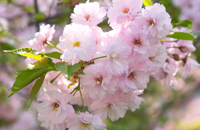 Like Shidarezakura, Yaezakura (ヤエザクラ) is not a name for a particular kind but is general name for any kind of cherry blossoms which a single blossom has more than 5 petals that bloom in layers (“yae” (yah-eh) literally means 8 layers). In extreme cases the petals can count up to as much as 300, looking more like a chrysanthemum or a peony. These kinds bloom comparatively late than Someiyoshino or Yamazakura, and last longer.
Like Shidarezakura, Yaezakura (ヤエザクラ) is not a name for a particular kind but is general name for any kind of cherry blossoms which a single blossom has more than 5 petals that bloom in layers (“yae” (yah-eh) literally means 8 layers). In extreme cases the petals can count up to as much as 300, looking more like a chrysanthemum or a peony. These kinds bloom comparatively late than Someiyoshino or Yamazakura, and last longer.
- Page 2 of 3
- « Previous
- 1
- 2
- 3
- Next »
